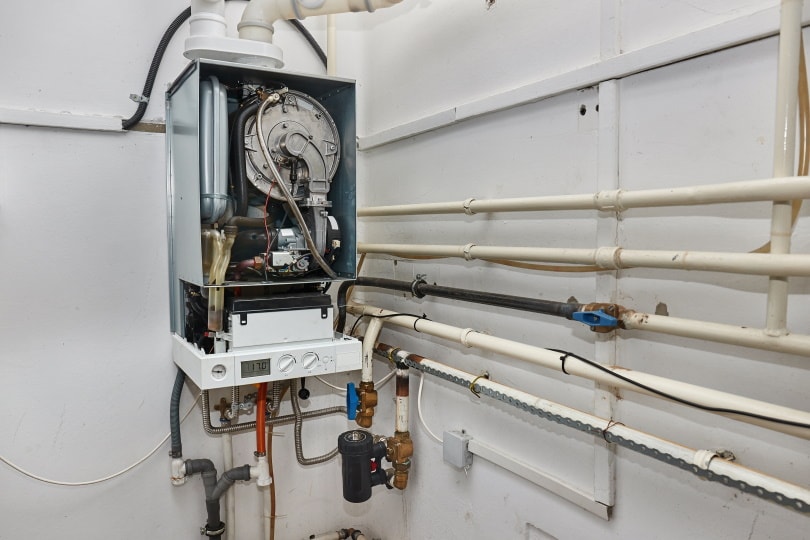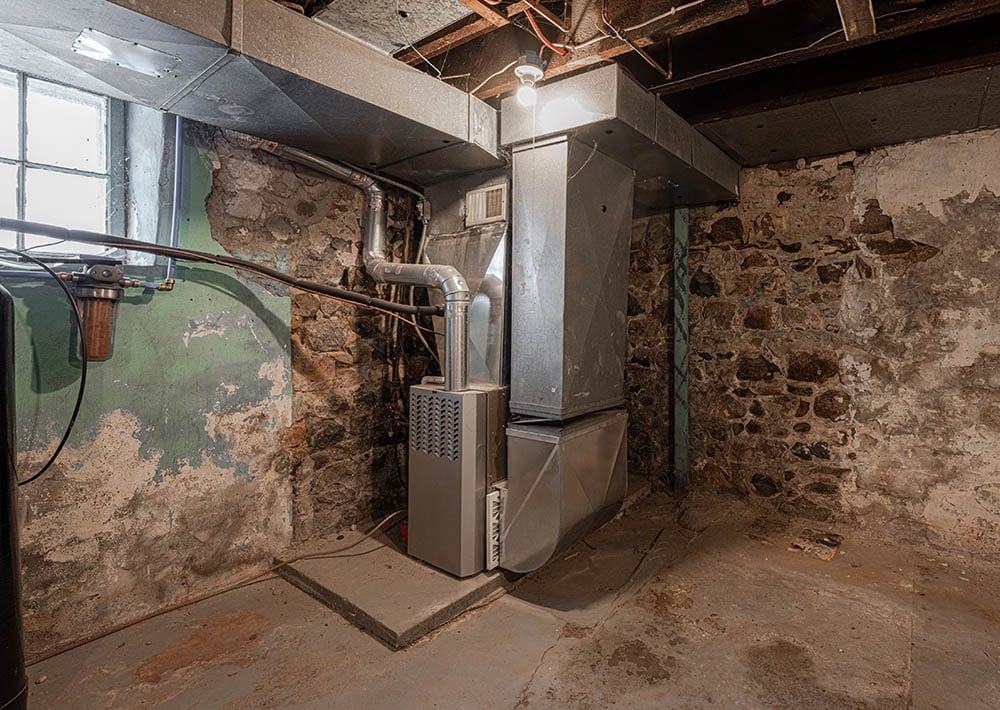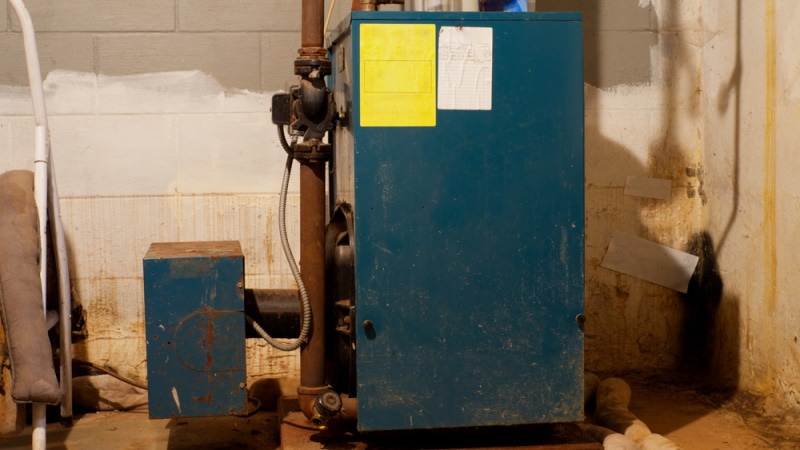How Does a Furnace Work? Types, Pros, Cons & FAQ
-
Jana Blagojevic
- Last updated:

Furnaces are heating systems that provide safe and reliable heating and supply an efficient amount of heat throughout your home. This heating system is energy-efficient and affordable as a starter investment. Before making any decisions, it is crucial to understand how a particular mechanism functions to choose the ideal furnace for your household. Since there are various furnaces, from electric to gas, you can find an explanation of all the possible types of furnaces below. Knowledge can also help you in the future, as you can maintain this system yourself and notice any performance issues if they occur.
The entire process begins with a single thermostat. Once you set up your thermostat to a different temperature from the one inside your home, your furnace unit receives the green light to begin heating. The electric furnace will begin heating its heat coils, and this ignition will produce your heat.
How Does It Work?
To begin understanding the exact process behind the genius of furnaces, we must go over their basic parts. Every furnace needs to have a burner, heat exchanger, vent pipe, ductwork, blower, flue, and a plenum.
Most modern furnace HVAC systems come with a venter motor, which pushes the heat from the burners to the heat exchanger. Depending on your thermostat’s settings, this motor tends to run for a preset amount of time, the amount it needs to reach the requested temperature inside the home.
If your furnace runs on gas, the heat rises into the heat exchanger, after which the gas valve is opened to provide enough fuel for the burners to run correctly. A flame sensor closely monitors the proper functioning of the burners.
The circulating fan will begin moving hot air through your ductwork and vents as the heat exchanger warms up. Any excess heat is properly vented through a chimney or any other type of outdoor-connected ventilation. Once your unit achieves its task, it will shut down, cool off and prepare for the next thermostat assignment.

The Importance of Knowing How a Furnace Works
Knowing the exact way a furnace works to provide heat is incredibly important. It can help you better understand the entire process behind it, as well as the reasons why it may be broken at some point. Knowing all its moving parts can be valuable if you’d like to easily troubleshoot a broken furnace in your home without needing a professional.
Understanding furnaces, their types, and how they work can help you pick the right furnace for your needs. It can also help you pick out the ideal HVAC partners who will take excellent care of your system.
The 4 Types of Different Furnaces
Luckily for every new shopper, there are plenty of excellent furnaces on the market to choose from. You can narrow your search by considering what type of furnace best suits your home. There are four main types of furnaces, and you can find more about their characteristics and design below.
1. Oil Furnaces

Oil furnaces usually have an efficiency of around 80% to 90%, much less than natural gas furnaces. The initial investment of purchasing oil furnaces is quite lower than other heating forms.
2. Propane Furnaces
Propane is a gas that is easily stored in tanks. While it is less conventional than electric furnaces, it is still used by many people.
3. Electric Furnaces

Electric furnaces have many benefits, especially considering how affordable installing them is. They are the cheapest type of furnace to purchase and install and tend to last around a decade longer than other furnaces. Nevertheless, the cost of electricity is incredibly high and only continues to grow, making these furnaces a bit less cost-efficient.
4. Natural Gas Furnaces
Natural gas furnaces are extremely energy efficient, especially newer models, with around 98% efficiency. It is one of the most popular heating choices in the US, with about half the country using natural gas as their primary fuel for heating.
Where Is a Furnace Located?
After you pick out the type of furnace you’d like to install, another critical question is—where should a furnace be installed?
The location of your furnace should ideally be in a space with adequate ventilation and enough room to fit this entire system. The area can be confined or unconfined, which is up to you, although you will need to consider the size of your furnace. If you choose to place your furnace in a confined space, your best choice would be the attic or crawlspace. The most common spaces where homeowners install their furnaces permanently are basements, garages, utility rooms, or other large spare rooms.
Advantages of Furnaces
There are many incredible benefits to using a furnace for heating your home, which is why most homeowners opt for this type of heating. Aside from being extremely affordable as an investment in the first place, they are also easy and cheap to maintain. They are durable and can serve you for many years with very few problems. They are safe to use and can serve you reliably even through the coldest winters.

Disadvantages of Furnaces
While electric furnaces are affordable to purchase and install, they can be quite costly to run due to higher utility bills. While gas furnaces are cheaper to run than electric furnaces, they have a shorter lifespan with more expensive maintenance. Gas furnaces also have fire or explosion risks considering their design.
Frequently Asked Questions (FAQs)
How to choose the right furnace for you?
When purchasing a furnace, there are several factors you will need to consider in order to pick out the right furnace for your household’s needs. The first thing to think about is the size of your home. The number of rooms, the ceiling height, and even the number of windows will determine the size of the furnace you need to install.
The second thing to consider is your budget. While you may want to go with the more affordable unit initially, it may be wiser to invest a bit more money and purchase a high-quality furnace. This will save you money in maintenance costs, leaving you with a perfectly running furnace without any issues. Before finalizing any decisions and purchasing a furnace, check out the reviews carefully, as certain features and information may be important to you.
Conclusion
Furnaces are excellent heating systems that service most US homes and provide reliable and comfortable heating for an affordable price. After reading about how furnaces actually function, you’ll have all the insight into this interesting process behind your home’s heating.
- What are the different types of furnaces? | Spurk HVAC
- Some Pros And Cons Of A Furnace | Heating and Air Conditioning
- Top 3 Reasons To Choose a Furnace for Your Home Heating System
- Where Should A Furnace Be Located In A House?
- How Does a Furnace Work? | Fire & Ice
- How Does a Furnace Work? Components, Functions, & Issues | SolvIt Home Services
Featured Image Credit: oasisamuel, Shutterstock
Contents


